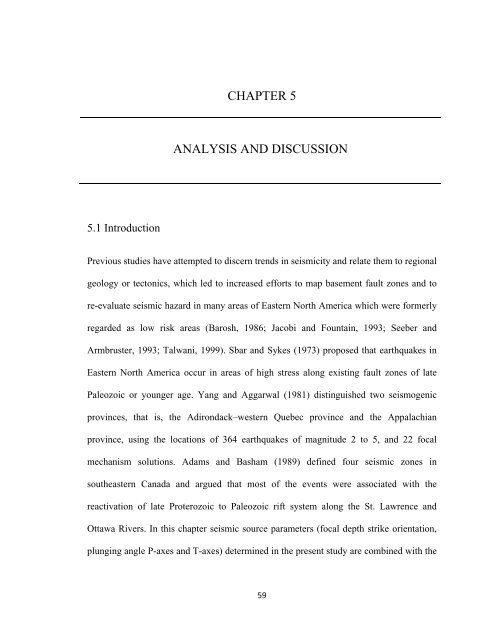western quebec and southern ontario - Department of Geology
western quebec and southern ontario - Department of Geology
western quebec and southern ontario - Department of Geology
You also want an ePaper? Increase the reach of your titles
YUMPU automatically turns print PDFs into web optimized ePapers that Google loves.
CHAPTER 5ANALYSIS AND DISCUSSION5.1 IntroductionPrevious studies have attempted to discern trends in seismicity <strong>and</strong> relate them to regionalgeology or tectonics, which led to increased efforts to map basement fault zones <strong>and</strong> tore-evaluate seismic hazard in many areas <strong>of</strong> Eastern North America which were formerlyregarded as low risk areas (Barosh, 1986; Jacobi <strong>and</strong> Fountain, 1993; Seeber <strong>and</strong>Armbruster, 1993; Talwani, 1999). Sbar <strong>and</strong> Sykes (1973) proposed that earthquakes inEastern North America occur in areas <strong>of</strong> high stress along existing fault zones <strong>of</strong> latePaleozoic or younger age. Yang <strong>and</strong> Aggarwal (1981) distinguished two seismogenicprovinces, that is, the Adirondack–<strong>western</strong> Quebec province <strong>and</strong> the Appalachianprovince, using the locations <strong>of</strong> 364 earthquakes <strong>of</strong> magnitude 2 to 5, <strong>and</strong> 22 focalmechanism solutions. Adams <strong>and</strong> Basham (1989) defined four seismic zones insoutheastern Canada <strong>and</strong> argued that most <strong>of</strong> the events were associated with thereactivation <strong>of</strong> late Proterozoic to Paleozoic rift system along the St. Lawrence <strong>and</strong>Ottawa Rivers. In this chapter seismic source parameters (focal depth strike orientation,plunging angle P-axes <strong>and</strong> T-axes) determined in the present study are combined with the59
















